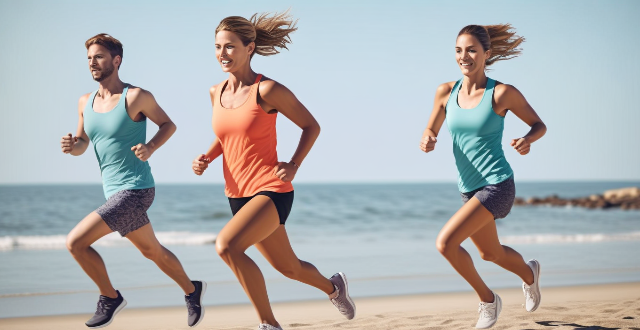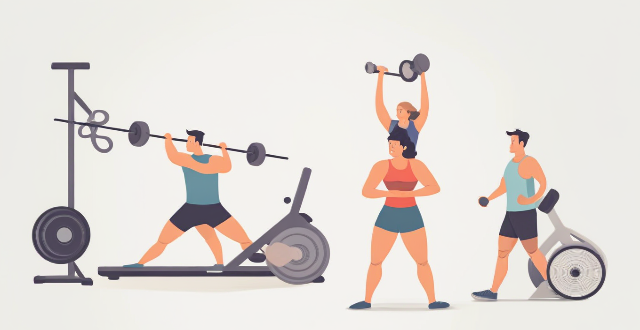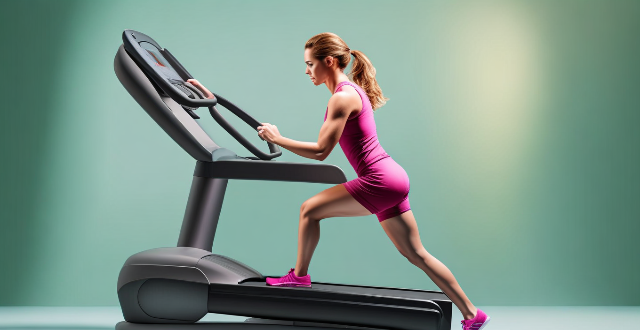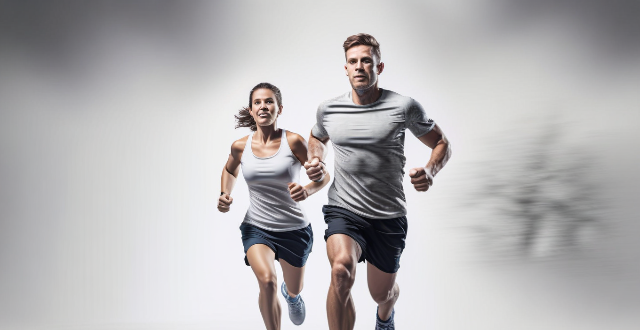Joint Knee

What are some effective ways to prevent knee injuries in sports ?
Knee injuries are common among athletes and can be quite severe, potentially leading to long-term damage or even the end of an athlete's career. There are several effective ways to prevent knee injuries in sports: 1. Proper Warm-Up and Cool-Down: A proper warm-up prepares your body for physical activity by increasing blood flow and warming up muscles. It should include gentle cardio exercises and dynamic stretches that mimic the movements you will perform during your sport. After exercise, gradually reduce your activity level with light stretching and walking to help remove lactic acid from your muscles and prevent stiffness. 2. Wear Appropriate Footwear: Choose shoes specifically designed for your sport that offer adequate support, cushioning, and shock absorption. Replace them regularly as they lose their ability to protect your knees over time. If needed, custom orthotics can provide additional arch support and correct any imbalances in foot alignment. 3. Strengthen Key Muscle Groups: Strong quadriceps help stabilize the patella (kneecap) and protect the knee joint. Exercises like leg presses, squats, and lunges can strengthen these muscles. Flexible hamstrings allow for proper knee extension and flexion during activities like running or jumping. Include hamstring curls and glute bridges in your routine. Strong glutes improve hip stability, which affects knee alignment. Include exercises like hip thrusts and fire hydrants in your workouts. 4. Improve Flexibility and Mobility: Regular static and dynamic stretching can increase flexibility around the knee joint, reducing the risk of injury. Focus on stretching the calves, hamstrings, quadriceps, and IT band. Incorporate mobility drills into your warm-up to improve range of motion at the knee joint. This could include ankle circles, high knees, or butt kicks. 5. Maintain Proper Technique: Ensure that you maintain proper form and alignment during all sports activities. Misaligned movements can place unnecessary stress on the knees. Work with coaches or trainers who can provide feedback on your technique and suggest modifications to reduce strain on your knees. 6. Cross-Train and Rest: Participating in low-impact activities like swimming or cycling can help build overall fitness while reducing repetitive stress on your knees from high-impact sports. Allow sufficient rest days between intense training sessions to give your body time to recover and avoid overuse injuries. 7. Use Supportive Gear When Needed: For athletes with pre-existing knee conditions or those returning from an injury, wearing supportive gear can provide additional stability and protection during activity. Kinesiology tape applied around the kneecap can help reduce pain and improve muscle function by providing subtle cues to the body about proper movement patterns.

How does understanding joint mechanics contribute to improving athletic performance through sports biomechanics ?
Understanding joint mechanics is crucial for improving athletic performance in sports biomechanics. By optimizing movement patterns, preventing injuries, enhancing force production, and improving stability, athletes can achieve greater success in their chosen sports. Sports biomechanists analyze an athlete's joint mechanics to develop targeted training programs that improve joint function and overall performance. Advances in sports technology provide real-time feedback on joint mechanics during training and competition, allowing athletes to fine-tune their technique and make adjustments to their training program as needed.

What are some good stretching exercises for after a run ?
After a run, it's important to stretch your muscles to prevent injury and improve flexibility. Here are some good stretching exercises for after a run: - Hamstring Stretch: Sit on the ground with your legs straight out in front of you, reach forward and try to touch your toes without bending your knees, hold for 15-30 seconds and repeat 2-3 times. - Quadriceps Stretch: Stand upright and bend one knee, bringing your heel towards your buttocks, grasp your ankle with one hand and hold onto a stable object with the other hand for balance, pull your foot closer to your buttocks until you feel a stretch in the front of your thigh, hold for 15-30 seconds and repeat 2-3 times on each leg. - Calf Stretch: Stand facing a wall with your hands placed against it at shoulder height, step one foot back behind you, keeping both heels flat on the ground, bend your front knee slightly while keeping your back leg straight, hold for 15-30 seconds and repeat 2-3 times on each leg. - Gluteal Stretch: Sit on the ground with your legs bent and feet flat on the floor, place your right ankle over your left knee, creating a "figure four" shape with your legs, gently push down on your right knee until you feel a stretch in your glutes, hold for 15-30 seconds and repeat 2-3 times on each side.

What are the benefits of swimming for overall health and fitness ?
Swimming offers numerous benefits for overall health and fitness, including improved cardiovascular health, muscle strength and tone, joint mobility and flexibility, weight management, mental health, injury recovery and rehabilitation, and socialization. It is a low-impact, high-intensity workout that engages all major muscle groups in the body, making it an effective way to build strength and tone muscles without putting undue stress on the joints. Additionally, the buoyancy of water helps to reduce pressure on the joints, making swimming an ideal exercise for people with arthritis or other joint issues. Swimming also burns a significant number of calories, making it an effective way to manage weight. The rhythmic nature of swimming can be meditative, helping to clear the mind and promote relaxation. Overall, swimming is a great way to improve overall health and fitness.

What are the benefits of a proper warm-up before physical activity ?
Warming up before physical activity is crucial for performance and injury prevention. Key benefits include increased blood flow, enhanced muscle temperature, joint lubrication, mental preparation, reduced injury risk, improved performance, and less muscle soreness. Incorporating a structured warm-up with dynamic stretching and specific exercises can maximize these benefits.

How do I know if I have a sports injury ?
Sports injuries can occur during physical activities or sports, and it is important to recognize the signs and symptoms to ensure proper treatment. Common symptoms include pain, swelling, stiffness, weakness, and instability. There are various types of sports injuries, such as sprains, strains, fractures, contusions, and dislocations. Seeking medical attention for a sports injury is essential to promote healing and prevent further damage. Treatment may include rest, ice, compression, elevation (RICE), physical therapy, medication, or surgery.

What are some effective warm-up exercises before starting a run ?
This article emphasizes the importance of warm-up exercises before starting a run. It discusses the benefits of dynamic stretching and light aerobic activities, such as high knees, butt kicks, leg swings, jogging in place, side shuffles, and high knees forward march. It also mentions static stretching as an optional component of warm-up routines, focusing on major muscle groups used during running. Finally, it highlights the necessity of proper cool-down and stretching post-run to aid muscle recovery and reduce soreness.

Are there any risks associated with high-impact exercises for bone health ?
High-impact exercises, such as jumping and running, are recommended for bone health but come with risks like overuse injuries, acute injuries, joint problems, and cardiovascular risks. Mitigating these risks involves gradual progression, proper technique, adequate rest, appropriate gear, and medical consultation.

What are the best exercises for recovering from a sports injury ?
Recovering from a sports injury requires a combination of exercises that focus on flexibility, strength, cardiovascular fitness, stretching, and balance/coordination. Range of motion exercises help maintain joint flexibility, while strengthening exercises build muscle strength around the injured area. Cardiovascular exercises improve circulation and promote healing, while stretching exercises reduce stiffness and improve flexibility. Balance and coordination exercises improve stability and prevent future injuries. Incorporating these exercises into your rehabilitation program can speed up recovery and return to sport. It is important to consult with a physical therapist or healthcare professional before starting any new exercise program.

How important is proper footwear in preventing sports injuries ?
The importance of proper footwear in preventing sports injuries is discussed, highlighting the need for ankle support, cushioning, traction, arch support, and toe protection. Wearing suitable shoes can help reduce the risk of sprains, strains, fractures, and other injuries common in sports. It is crucial to choose shoes that fit well, offer adequate support, and are appropriate for the specific sport or activity.

What are the most common causes of sports injuries ?
Sports injuries can be caused by a variety of factors, including physical stress, poor technique, inadequate equipment, and environmental conditions. Overuse injuries occur when an athlete repeatedly performs the same motion or activity without adequate rest or recovery time. Traumatic injuries are typically caused by sudden impact or forceful contact during sports activities. Improper technique while participating in sports can increase the risk of injury. Inadequate equipment can also increase the risk of injury. Environmental conditions such as weather, terrain, and lighting can contribute to sports injuries.

Are there any specific exercises that can help prevent sports injuries ?
To prevent sports injuries, it's important to engage in specific exercises that focus on warm-up and stretching, strength training, plyometrics, and core strengthening. Warm-up exercises like jogging or brisk walking, along with dynamic stretches, help prepare the body for physical activity by increasing blood flow and reducing injury risk. Stretching exercises such as hamstring and quadriceps stretches improve flexibility and range of motion. Strength training exercises like squats and planks build strength in key muscle groups, improving stability and reducing joint stress. Plyometric exercises like box jumps and lateral bounds enhance power, speed, and agility. Core strengthening exercises like bicycle crunches and plank with hip dips provide stability and support during physical activities. By incorporating these exercises into your routine, you can reduce the risk of sports injuries and improve your overall athletic performance.

What are the most common sports injuries and how can they be prevented ?
Common sports injuries include knee, ankle, shin, shoulder, hamstring, concussions, Achilles tendinitis, wrist, swimmer's shoulder and runner's knee. Injury prevention strategies include strengthening exercises, proper warm-up/cool-down routines, wearing supportive shoes and protective gear, gradually increasing the intensity of physical activity, stretching before and after exercise, and learning proper techniques to avoid head collisions or overusing certain muscles.

What's wrong with the belief that cardio is the best way to lose weight ?
This critical analysis challenges the prevailing belief that cardio exercises are the most effective way to lose weight. It argues that this belief is misguided due to an overemphasis on calorie burning, neglect of other forms of exercise, potential for overuse injuries, and limited sustainability and enjoyment. The analysis suggests a well-rounded fitness routine that includes strength training, flexibility exercises, and other forms of physical activity to support overall health, prevent injuries, and ensure long-term success in maintaining a healthy weight.

What are some dynamic warm-up exercises that can be done before running ?
Dynamic warm-up exercises are essential for runners to improve performance and reduce injury risk. These include high knees, butt kicks, leg swings (front and side), walking lunges, toy soldiers, ankle circles, side shuffles, plank to runner's lunge, jumping jacks, and light jogging. Each exercise targets specific muscles and joints, enhancing mobility, flexibility, and circulation. Completing these warm-ups prepares the body for running, ensuring better efficiency and comfort during the activity.